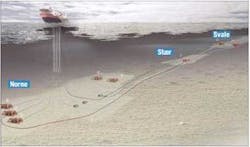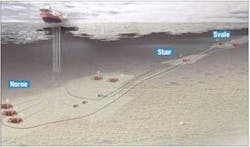Statoil looking for increased yield from Norne satellites
Nick Terdre
Contributing Editor
Satellite development is under way in the Norne area of Mid-Norway, foll-owing government approval last month for Statoil's Svale and Stær projects. In view of the other reserves discovered in this part of the Norwegian Sea and the area's remaining exploration potential, this is likely to be just the first step in the development of Norne satellites.
Svale and Stær, which contain around 66 MMbbl of oil, will be developed with subsea facilities tied back to an FPSO. The project is scheduled to achieve start-up in October 2005. Two four-slot subsea templates will be installed on Svale, on which three production wells and two water injectors will be drilled, with one template on Stær, housing two producers and one injector. The water depth is 380 m.
A single 15-in. production pipeline will tie the two fields back to Norne. Both lie in the same northeasterly direction from the ship, Stær being 4.5 km distant and Svale 9 km. The line will be made of clad steel and equipped with electrical cables so that it can be heated to prevent hydrate formation during production shutdowns. There will also be a 10-in. flexible water line, a 5-in. lift-gas line, and a control umbilical. Two new risers, for production and injection water, will be installed at the vessel.
null
The main contracts have been awarded to:
- FMC Kongsberg Subsea (FKS), for the supply of subsea equipment, including trees, manifolds, templates, and controls. The templates, with integrated protection structures, are unusually heavy, weighing 320 tonnes each
- Transocean for drilling with semi Trans-ocean Arctic. The rig, which is scheduled to start work on the satellite wells in the autumn, has been upgraded to give it a well completion capability
- Stolt Offshore, for the supply and installation of flexible risers and the flexible water flowline, umbilical installation, and tie-ins
- Technip Offshore Norway for fabrication and reeled installation of the production and lift-gas pipelines. This will be the first ever, reeled, clad pipeline
- Aker Reinertsen, for topside modifications on the FPSO
- Aker Marine Contractors, for installation of the templates in September with the newbuild vessel DeepC Boa.
Other contracts have gone to DNV for pipeline engineering, Tenaris of Argentina for supply of the carbon steel lift-gas line, and Sumitomo/Japan Steel Works for the clad steel and lift-gas line-pipe. FKS subcontracted Norwegian yard Grenland Offshore to fabricate the templates and Warynski Famabud in Poland the hatches and production guide bases for the templates, which arrived in Norway in June.
Norne, the most northerly field yet developed in the Norwegian sector, came on-stream in 1997. It came off its peak in 2001, when it produced 69 MMbbl. Subsequent appraisal drilling led to a reduction in the field's estimated reserves from 80 to 50 MMbbl.
The prospect of a commercial satellite development only appeared realistic when Stær was discovered in 2002, according to Annefi Markman, vice president for Norne production.
Before this could be realized, two other factors had to be resolved, Markman says. The first was the type of technology required. As Statoil had made another find at Falk and had other prospects to drill in the area, it seemed that the volume of satellite reserves might exceed the Norne ship's capacity. The Norne Technology Program was set up to examine the use of new technology that could bypass this problem and reduce costs in other ways. One of the key technologies studied was the seabed separation of water.
As it happened, some of the subsequent exploration drilling proved disappointing, and the team concluded that the first stage of satellite development should be restricted to Stær and Svale. The production volume, which will peak at 70,000 b/d in 2006, is within Norne's capacity, so the project requires only conventional technology. At the same time, ways were found of reducing the scope of topsides modifications by 50%. Together these two developments made the project an attractive proposition. The investment budget is NKr3.6 billion, and the expected rate of return around 16%.
Probably the most technically complex part of the development will be the well completions, Markman says. DIACS systems will be installed downhole, combined with gas-lift, downhole scale inhibitor, gravel packs, and sand screening. Sand production is relatively large in the Norne wells, and the same is expected in the satellites.
Statoil currently expects to achieve a 40% rate of recovery from the satellite reservoirs, but will be looking to increase this, Markman says. It has already exceeded its expectations on Norne, where its recovery estimate was originally 44% but has now been raised to 55%.
The infrastructure for Stær and Svale is likely to prove useful for the further development of reserves in the area. A small oil discovery was made last year in Lerke, which lies between Stær and Svale, and which could be drilled from one of the new templates. The same is true of Svale North, a so far undrilled prospect. A second focus for exploration is in the Valkyrie area further to the northeast of Norne.

